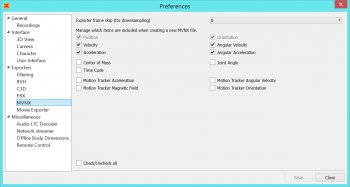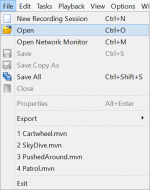Xsens
| Language: | English • français • italiano • português • español |
|---|
For more information about Xsens, visit the Xsens Website.
Introduction
Xsens uses IMU's to track motion, and processes the information in MVN, resulting in an MVNX file or a C3D file. Visual3D can directly read either the C3D or the MVNX file. Please note that raw data from Xsens or any IMU's is not useful for biomechanics without post-processing to generate POSE information.
This feature was released in Visual3D v5.02.24. If using version 5 to process your data, please follow the instructions here.
Background
Typically, Visual3D reads data in the C3D file format which contains target locations from a motion capture system. Although Xsens can export C3D files, there are reasons why a user may prefer to export Xsens data as an MVNX file. Visual3D compatible Xsens .mvnx files should contain the following variables for each segment : orientation, position, velocity, acceleration, angularVelocity, angularAcceleration. (See "Exporting from MVN Studio" below)
Model Pose (position and orientation):
Visual computes the model Pose using a "Link Model" that matches the Xsens link model. The model's root, which is the pelvis, has both an orientation and a position (all 6 degrees of freedom). Visual3D then work through model's chain (assuming a ball and socket at all joints) using the .mvnx segment orienation variables to compute the joint angles. This give us the position and orientation (POSE) of the entire model.
Segment Kinematics:
In the data tree, under KINETIC_KINEMATIC you can see there are "Pose" based variables one could use to reconstruct an the model (ProxEndPos, DistEndPos and CGPos) . Note these Pose based variables are computed directly from .mvnx orientation data (and pelvis position) as described above.
In the KINETIC_KINEMATIC there are also "velocity and acceleration" variables (AngAcc, AngVel, CGAcc, CGVel, DistEndVel and ProxEndVel.) These are obtained from the .mnx file variables : velocity, accelaration, angularVelocity and angularAcceleration. (The velocity and acceleration are at the segment origin.) Note these variables and not are not obtained via derivatives of the pose variables. (Relative motion equations are used to compute the "velocity and acceleration" variables from the Xsens input.)
Finally for the other kinematic variables that can be obtained via Compute_Model_Based_Data, position and orientation based variables come from the "Pose" variables in the KINETIC_KINEMATIC tree and velocity and acceleration data come from "velocity and acceleration" variables in the KINETIC_KINEMATIC tree.
Segment Kinetics:
Once Visual3D creates the KINETIC_KINEMATIC variables: ProxEndPos, DistEndPos, CGPos, AngAcc, AngVel, CGAcc (and the ground reaction force if needed) we have all we need to compute the inverse dynamics.
Note:
If you take the first derivative of the ProxEndPos KINETIC_KINEMATIC variable it will not exactly equal the ProxEndVel KINETIC_KINEMATIC variable which come from the .mvnx Translational Velocity of the Origin. The idea is to use the Xsens data for velocity, acceleration and kinetic calculations even if it is slightly inconsistent with the derivative of the Pose data. (This data is assumed to be more accurate measure of velocity and acceleration then taking the derivatives of which amplifies noise.)
Download Files
- Sample MVNX files
- These sample MVN files were downloaded from the Xsens Website and then exported from MVN Studio as MVNX files
Exporting Xsens Data
|
Visual3D reads the MVNX files. To create the MVNX files, you must first collect or load motion data into MVN studio and then export the data MVNX format. It is very important that the MVNX export settings are defined correctly. This is explained in the "Exporting from MVN Studio section" (Step 2). |
Exporting from MVN Studio
When exporting the mvnx file from MVNX studio, it is important to export the Position, Orientation, Velocity, Angular Velocity, Acceleration, and Angular Acceleration should be exported. Below are instructions to complete this in MVN Studio.
|
1. Open MVN Studio |
|
2. Modify the export settings
If any of these signals (translational velocity, translational acceleration, angular velocity, angular acceleration) are missing from the MVNX file, the derivatives of the position data will be used to calculate these signals. NOTE: Once you have set this, these changes will be saved even after MVN Studio is closed. So you only need to do this step once. |
|
3. Load the data |
Opening MVNX Files
As of Visual3Dv6, MVNX files can be opened by going to File -> Open in Visual3D.
They can also be opened using the File_Open pipeline command. When the file is opened, the user will be prompted for all the necessary model metrics to create the model.
Processing Xsens Data
Trunk Graphic
The default Xsens model points to the thoraciccerviclet12toacromium_noneck.obj graphic.
This means if the graphic does not appear in your model, you can download the graphic here, unzip the files (obj and mtl), and place them in your default graphics folder. Once the graphic file is placed in the models folder, you may need to close and re-open Visual3D. Instructions to find your models folder can be found here.
Prop Sensors
Visual3Dv2020.## supports reading MVNX files with one prop sensor. The sensor will be loaded automatically as a segment (ex. PR1). If more props are required to process your data, please contact C-Motion. When using an Xsens prop in Visual3D, all information is loaded automatically and no further steps are required. A sample MVNX file with a prop can be downloaded here.
This tutorial explains how to adjust the location of the prop segment and assign a graphics object to the prop using a script.


